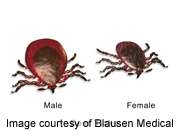Case reports look at 2 older patients with Borrelia miyamotoi infection.
(HealthDay)—Physicians say a new kind of tick-borne infection that's similar to Lyme disease can mislead doctors into thinking it's a different condition.
Borrelia miyamotoi can cause flu-like symptoms that are similar to Lyme disease, researchers found.
"In the few case reports available for patients in the U.S., symptoms of B. miyamotoi infection have included fever, fatigue, body aches, joint pain and headache," said Dr. Bobbi Pritt, director of clinical parasitology at the Mayo Clinic in Rochester, Minn. Pritt was not involved in the research.
Researchers also think infection may cause dementia in the elderly, especially those who have conditions that weaken the immune system.
Lab tests also show low blood platelet counts and elevated liver enzymes, Pritt said.
However, scientists have developed a blood test that detects signs of the disease, and the infection has been fairly simple to treat so far.
It's not clear how widespread the infection has become in the areas of the United States like the Northeast, where ticks commonly spread disease. At the moment, scientists think the infection, caused by bacteria known as Borrelia miyamotoi, is fairly uncommon.
Still, "researchers are reporting that it's in 1 to 4 percent of ticks from Massachusetts and Rhode Island," said Dr. Philip Molloy, medical director of Norwood, Mass.-based Imugen Inc. The company's tests are producing a better picture of the infection's spread by identifying more cases, said Molloy, co-author of a new report about the detection of the disease.
Scientists have known about B. miyamotoi, which is found on deer ticks (also known as blacklegged ticks), for more than a decade. But researchers have only started finding it in people over the last couple of years, and they suspect it may infect a few thousand Americans annually.
Lyme disease appears to be much more prevalent—striking perhaps 30,000 Americans a year—and much more of a health threat because of the potential for lasting complications.
The new report says two people, in Massachusetts and New Jersey, were initially thought to have human granulocytic anaplasmosis, one of several diseases caused by germs that ride on ticks. But the patients didn't quickly respond to treatment with the antibiotic doxycycline, and tests showed they didn't have the disease.
However, tests did show signs of Borrelia miyamotoi. The patients, one of whom may also have had Lyme disease, eventually responded to treatment with doxycycline. Both recovered, although one—an 87-year-old man—was ill for weeks.
The patients sought treatment in 2011 and 2012.
The report says physicians should consider Borrelia miyamotoi to be a possibility when patients have symptoms similar to those of human granulocytic anaplasmosis but don't seem to suffer from that disease.
For the moment, there are no guidelines about how to treat the infection. "The most we have is 'a doctor gave a patient this, and they got better.' There's no formal antibiotic treatment," report co-author Molloy said.
However, all patients thought to have been infected with B. miyamotoi in the United States have recovered with the use of antibiotics, said Pritt, the Mayo Clinic specialist.
Molloy said his firm now offers a blood test that detects signs of infection with B. miyamotoi. He expects doctors will learn how to properly treat the disease as the tests confirm more cases.
What to do? Tick specialists recommend that people who may be exposed to ticks in the woods or elsewhere follow these precautions:
- Use an insect repellant with DEET, permethrin or picaridin.
- Wear pants and tuck them into your socks.
- Avoid going to areas with many ticks.
- Check yourself, your family and pets carefully for ticks.
The report appears in the July 2 issue of Annals of Internal Medicine.
More information: For more about tick bites, try the U.S. National Library of Medicine.
Journal information: Annals of Internal Medicine
Health News Copyright © 2013 HealthDay. All rights reserved.
























